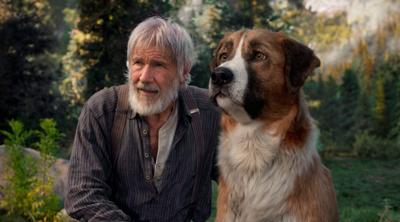"I never saw him believe in anything as much as he believes in you." — Françoise (Cara Gee)
We used to have 11 cats, but lost them one by one, mostly to old age. In the meantime, my son brought a puppy into the house. We added two more and went from cat house to dog house. Now I can't imagine there was ever a time when we didn't have dogs.
But our dogs, like ourselves, are far from their untamed ancestors. Instead of hunting and fighting, they spend their days patrolling the backyard, and their evenings watching TV and cuddling their humans on the couch.
They're the living antithesis to author Jack London's 1903 best-seller, The Call of the Wild, which fifth grade classes have read for nearly a century, though I barely remember doing so. Neither do I remember any better the best known of the half-dozen film adaptations, the 1935 version starring Clark Gable. London, who did his own adventuring in the Klondike Gold Rush of the 1890s, essentially argued for primitivism over the industrialization of the Victorian era, as his canine hero, Buck, can only achieve his destiny — and safety from civilized humans — by gradually shedding his domesticity and literally joining a wolf pack.
The message is clear: Animals, connected to their roots, are innocent and noble; humans, perverted by the veneer of society, are treacherous and evil.
Not all humans, of course. After being dognapped from his home in California and mistreated by a string of humans, Buck becomes a sled dog for postal deliverers Perrault and Françoise (in this adaptation, Omar Sy and Cara Gee), who come to love Buck. When the encroaching telegraph shuts down the Alaskan mail run, Perrault and Françoise must sell Buck, whereupon he begins a long relationship with John Thornton (Harrison Ford), which includes both of them healing their respective psyches by forsaking civilization for the last frontier.
There's two huge hurdles to get over in director Chris Sanders' new version.
First: Buck isn't a real dog. He's a computer-generated cartoon, with actor/gymnast Terry Notary, best known for motion-capturing Kong in Kong: Skull Island, standing in on set. From the previews, I didn't believe I could get past the anthropomorphic Buck. He looks like, and is, at best, a Disney cartoon (the film is the first 20th Century Studios film released by Disney after the Mouse bought the Fox), and, at worst, a stand-in for Scooby Doo. Nevertheless, I'll grudgingly admit that, as the film progressed, I became able to sympathize with Buck.
No, I didn't get misty-eyed. OK, maybe I did.
Central to the suspension of disbelief is the reaction of the human actors to an animal who isn't there. I'll say right now that John Thornton is one of Ford's best performances, fully matched by Sy and Gee. Dan Stevens, however, as an almost literally mustache-twirling villain, is less believable than the cartoon dog, through no fault of his own as an actor.
Because here's the other big snag: London purists aren't going to like it because the story is massively reworked by screenwriter Michael Green. Stuff that should be R-rated is toned down virtually to PG, with the climax bearing little resemblance whatsoever to London.
Nevertheless, as a quote-unquote "family film," The Call of the Wild is perfectly acceptable and enjoyable, with stunning cinematography from Oscar winner Janusz Kamiński
Director Sanders gets the most important thing right: how man and dog should treat each other, whether in the arctic or in the backyard.










